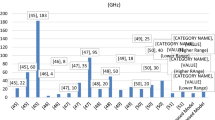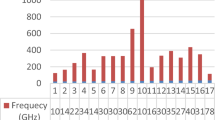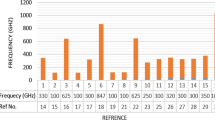Abstract
Mobile providers must be preparing for a rapid increase with mobile traffic in future, given the significant growth in demand for wireless data capacity for communications link every year. This motivates researchers and scientist for the higher spectrum bands. The major challenges for these bands are their more sensitive nature toward environmental factors like rain, dust, clouds etc. for the prediction of rain attenuation, various mathematical and empirical models are existed. Those models are not so accurate and complex. As technologies like Machine Learning and Artificial Intelligence are emerging to make any system smarter. Telecom engineers are looking for these technologies for making telecom system smarter. This research develops a model based on Artificial Neural Networks (ANN). The AMSER2 satellite supplied real-time data for this model's training. When compared to previous research, the suggested model will be more accurate. The development of next-generation communication systems will benefit from this model technique (6G).











Similar content being viewed by others
Data availability
Data is availlable and provided on request.
Availability of Data and Material (data transparency)
All data used in this research are available. We can provide whenever ask to do so.
Code availability(software application or custom code)
All codes used in this research are available. We can provide whenever ask to do so.
References
Henri Sauvageot, L., & Castanet, J. L. (2003). HYCELL – A new hybrid model of the rain horizontal distribution for propagation studies: Modelling of the rain cell. Radio Science Journal. https://doi.org/10.1029/2002RS002802
Gunn, R., & Kinzer, G. D. (1949). The terminal velocity of fall for water droplets in stagnant air. Journal of Meteorology, 6(4), 243–248.
Spilhaus, A. F. (1948). Raindrop size, shape and falling speed. Journal of Meteorology, 5(3), 108–110.
Brussaard, G. (1974). Rain-induced crosspolarisation and raindrop canting. Electronics Letters, 10(20), 411–412.
Kathiravelu, G., Lucke, T., & Nichols, P. (2016). Rain drop measurement techniques: A review. Water, 8(1), 29.
Williams, C. R., Gage K.S. (2009). Raindrop size distribution variability estimated using ensemble statistics." Annales geophysicae: atmospheres, hydrospheres and space sciences. 27(2)
Marshall, J. S., & Palmer, W. M. K. (1948). The distribution of raindrops with size. J. Meteor., 5, 165–166.
Illingworth, A. J., & Blackman, T. M. (2002). The need to represent raindrop size spectra as normalized gamma distributions for the interpretation of polarization radar observations. Journal of Applied Meteorology, 41, 286–297.
Zhang, G., Vivekanandan, J., Brandes, E., Meneghini, R., & Kozu, T. (2003). The shape-slope relation in observed gamma raindrop size distributions: Statistical error or useful information. Journal of the Seismological Society of Japan, 20, 1106–1119.
Feingold, G., & Levin, Z. (1986). The lognormal fit to raindrop spectra from frontal convective clouds in Israel. Journal of Applied Meteorology, 25, 1346–1364.
Baltas, E. A., and M. A. Mimikou. (2002). The use of the Joss-type disdrometer for the derivation of ZR relationships.In: Proceedings of ERAD. 291: (294)
ITU-R (2007). Propagation data and prediction methods required for the design of Earth-space Telecommunication system", Rec. ITU-R P.618–9
Stutzman, W. L., & Yon, K. M. (1986). A simple rain attenuation model for earth-space radio links operating at 10–35 GHz. Radio science, 21(1), 65–72.
Prasad, M. V. S. N., Sarkar, S. K., Sain, M., & Reddy, B. M. (1994). Comparison of rain attenuation prediction method for earth-space paths over northern India.
Luini, L., & Capsoni, C. (2010, April). A physically based methodology for the evaluation of the rain attenuation on terrestrial radio links. In Proceedings of the fourth european conference on antennas and propagation (pp. 1–5). IEEE.
Chung, T. K. P., Gallois, A. P., & Gremont, B. C. (1995). Frequency scaling of rain attenuation: Results from Olympus satellite. In 1995 Ninth International Conference on Antennas and Propagation, ICAP'95 (Conf. Publ. No. 407) (Vol. 2, pp. 178–181). IET.
Qingling, Z., & Li, J. (2006, October). Rain attenuation in millimeter wave ranges. In 2006 7th international symposium on antennas, propagation & EM theory (pp. 1–4). IEEE.
Moupfouma, F. (2009). Electromagnetic waves attenuation due to rain: a prediction model for terrestrial or LOS SHF and EHF radio communication links. Journal of Infrared, Millimeter, and Terahertz Waves, 30(6), 622–632.
Kumar, V., Singh, H., Saxena, K., Bonev, B., & Prasad, R. (2021). Soft Clustering for Enhancing ITU Rain Model based on Machine Learning Techniques. Wireless Personal Communications, 120, 1–19.
Busari, H. O., & Fakolujo, O. A. (2021). Estimation of attenuation due to rain within Ka and Ku bands in Oyo State of Nigeria. FUOYE Journal of Engineering and Technology, 6(1).
Kumar, A., Rathore, N. S., & Pandey, A. K. (2021). A scientific study on effect of polarization in calculation of rain attenuation using ITU-R Model. In Renewable power for sustainable growth (pp. 367–376). Springer, Singapore.
Ashidi, A. G., Ojo, J. S., Ajayi, O. J., & Akinmoladun, T. M. (2021). Evaluation of concurrent variation in rain specific attenuation and tropospheric amplitude scintillation over akure. Southwest Nigeria. Earth Systems and Environment, 1–13, 547.
Darley, O. G., Yussuff, A. I., & Adenowo, A. A. (2021). Investigation into rain attenuation prediction models at locations in lagos using remote sensing. FUOYE Journal of Engineering and Technology, 6(2), 19.
Quibus, L., Le Mire, V., Queyrel, J., Castanet, L., & Féral, L. (2021). Rain Attenuation estimation with the numerical weather prediction model wrf: impact of rain drop size distribution for a temperate climate. In 2021 15th European Conference on Antennas and Propagation (EuCAP) (pp. 1–5). IEEE.
Elmutasim, I. E., & Mohd, I. I. (2021). Examination rain and fog attenuation for path loss prediction in millimeter wave range. In Proceedings of the 11th National Technical Seminar on Unmanned System Technology 2019 (pp. 935–946). Springer, Singapore.
Semire, F. A., Adekunle, A. J., Abolade, R. O., & Adegbola, O. A. (2021). Prediction of rain attenuation trend due to climate change in some locations of Southwestern Nigeria. Radioelectronics and Communications Systems, 64(1), 45–52.
Alonge, A. A. (2021). Semi-empirical characteristics of modified lognormal DSD inputs using rain rate distributions for radio links over the African continent. Advances in Space Research, 67(1), 179–197.
Chen, Y., Wang, Y., & Dong, Y. (2021). Performance Analysis of Polar Codes against Rain Attenuation in Ka-band Satellite Communication. In 2021 International Conference on Communications, Information System and Computer Engineering (CISCE) (pp. 146–150). IEEE.
Nandi, D., Pérez-Fontán, F., Pastoriza-Santos, V., & Machado, F. (2021). Analysis of rain fade characteristics from experimental satellite measurements at Ka/Q bands for a temperate location Vigo. Spain. Advances in Space Research., 68, 1754.
Bandi, A. (2021). An empirical model to overcome the attenuation caused due to rain. Spast Abstracts, 1(01).
Busari, H. O., & Fakolujo, O. A. (2021). Rain attenuation prediction models in microwave and millimeter bands for satellite communication system: a review. FUOYE Journal of Engineering and Technology. 6(1)
Kovalchuk, M., & Fiser, O. (2021). Classical processing of attenuation on alphasat satellite link in prague. In 2021 20th international conference on microwave techniques (COMITE) (pp. 1–6). IEEE.
Pimienta-del-Valle, D., Riera, J. M., Garcia-del-Pino, P., Siles, G. A., & Benarroch, A. (2021). Propagation Experiments in Madrid for the Ka and Q Bands: Recent Results and Rain Attenuation Modelling in the Earth-Satellite Channel. In 2021 15th european conference on antennas and propagation (EuCAP) (pp. 1–5). IEEE.
Pudashine, J., Guyot, A., Overeem, A., Pauwels, V. R., Seed, A., Uijlenhoet, R., & Walker, J. P. (2021). Rainfall retrieval using commercial microwave links: Effect of sampling strategy on retrieval accuracy. Journal of Hydrology, 603, 126909.
Singh, Hitesh, et al. "Proposed Model for Radio Wave Attenuation due to Rain (RWAR) (vol 115, pg 791, 2020)." Wireless Personal Communications (2021).
Singh, H., et al. (2020). An empirical model for prediction of environmental attenuation of millimeter waves. Wireless Personal Communications., 1151, 809–826.
Singh, Hitesh, et al. (2020). An Intelligent model for prediction of attenuation caused by rain based on machine learning techniques. In: 2020 International conference on contemporary computing and applications (IC3A). IEEE
Singh, H., et al. (2022). A smart model for prediction of radio wave attenuation due to clouds and fog (SMRWACF). Wireless Personal Communications, 1224(2022), 3227–3245.
Kumar, V., et al. (2021). Soft Clustering for Enhancing ITU Rain Model based on Machine Learning Techniques.". Wireless Personal Communications, 1201, 287–305.
Singh, Hitesh, et al. (2021) Prediction of radio wave attenuation due to clouds Using ANN and its business aspects.In: 2021 29th national conference with international participation (TELECOM). IEEE
Singh, Hitesh, et al. "Prediction of Radio Wave Attenuation due to Cloud Using Machine Learning Techniques.In 2021 56th international scientific conference on information, communication and energy systems and technologies (ICEST). IEEE, 2021.
Kumar, V et al. (2021) Approximations for ITV Rain Model Using Machine Learning.In 2021 56th international scientific conference on information, communication and energy systems and technologies (ICEST). IEEE, 2021.
Kumar, Vivek, et al. (2021) An ANN Model for Predicting Radio Wave Attenuation due to Rain and its Business Aspect.In 2021 29th national conference with international participation (TELECOM). IEEE.
Singh, H., Kumar, V., Saxena, K., & Bonev, B. (2021). Computational intelligent techniques for prediction of environmental attenuation of millimeter waves. Security and Privacy Issues in IoT Devices and Sensor Networks, 263–284.
Singh, H., Prasad, R., & Bonev, B. (2018). The studies of millimeter waves at 60 GHz in outdoor environments for IMT applications: a state of art. Wireless Personal Communications, 100(2), 463–474.
Singh, H., Bonev, B., & Chandra, A. (2018). Effects of Atmospheric Impairments of Satellite Link Operating in Ka Band. Wireless Personal Communications, 101(1), 425–437.
Alencar, G. A. (2004, August). Low statistical data processing for applications in Earth-space paths rain attenuation prediction by an artificial neural network. In 2004 asia-pacific radio science conference, 2004. proceedings. (pp. 344–346). IEEE.
Thiennviboon, P., &Wisutimateekorn, S. (2019). Rain attenuation prediction modeling for Earth-space links using artificial neural networks. In 2019 16th international conference on electrical engineering/electronics, computer, telecommunications, and information technology (ECTI-CON) (pp. 29–32). IEEE.
Mpoporo, L. J., Owolawi, P. A., & Ayo, A. O. (2019, November). Utilization of artificial neural networks for estimation of slant-path rain attenuation. In 2019 international multidisciplinary information technology and engineering conference (imitec) (pp. 1–7). IEEE.
Livieratos, S. N., & Cottis, P. G. (2019). Rain attenuation along terrestrial millimeter wave links: A new prediction method based on supervised machine learning. IEEE Access, 7, 138745–138756.
Li, T., Suzuki, K., Nishioka, J., Mizukoshi, Y., & Hasegawa, Y. (2015, October). Short-term rainfall attenuation prediction for wireless communication. In 2015 IEEE 16th international conference on communication technology (ICCT) (pp. 615–619). IEEE.
Ahuna, M. N., Afullo, T. J., & Alonge, A. A. (2019). Rain attenuation prediction using artificial neural network for dynamic rain fade mitigation. SAIEE Africa Research Journal, 110(1), 11–18.
Amarjit, & Gangwar, R. P. S. (2008). Implementation of artificial neural network for prediction of rain attenuation in microwave and millimeter wave frequencies. IETE Journal of research, 54(5), 346–352.
Zhao, L., Zhao, L., Song, Q., Zhao, C., & Li, B. (2014). Rain attenuation prediction models of 60GHz based on neural network and least squares-support vector machine. In The Proceedings of the Second International Conference on Communications, Signal Processing, and Systems (pp. 413–421). Springer, Cham.
Roy, B., Acharya, R., & Sivaraman, M. R. (2012). Attenuation prediction for fade mitigation using neural network within situ learning algorithm. Advances in space research, 49(2), 336–350.
Singh, H., Kumar, V., Saxena, K., &Bonev, B. (2020, February). An Intelligent model for prediction of attenuation caused by rain based on machine learning techniques. In 2020 international conference on contemporary computing and applications (IC3A) (pp. 92–97). IEEE.
Houze Jr RA. (1993). Cloud dynamics, 573 pp. San Diego: Academic. Google Scholar.
Jang, K. J., Yoon, Y., Kim, J., Kim, J. H., & Hwang, G. (2021). Rain attenuation prediction model for terrestrial links using gaussian process regression. IEEE Communications Letters., 25, 37.
Wentz, F.J., T. Meissner, C. Gentemann, K.A. Hilburn, J. Scott, (2014).: Remote sensing systems GCOM-W1 AMSR2 [Daily data] environmental suite on 0.25 deg grid, Remote Sensing Systems, Santa Rosa, CA. Available online at www.remss.com/missions/amsr.
Funding
This work was not supported by the financial Grant from any organization.
Author information
Authors and Affiliations
Contributions
Did work for machine learning model for rain attenuation which will be helpful in future technology implementation.Add state of art for Rain attenuation in last few years.Implement machine and AI based model for radio wave propagation particular for 5G signal range.
Corresponding author
Ethics declarations
Conflicts of interest
There is no any conflicts of interest.
Additional information
Publisher's Note
Springer Nature remains neutral with regard to jurisdictional claims in published maps and institutional affiliations.
Rights and permissions
Springer Nature or its licensor (e.g. a society or other partner) holds exclusive rights to this article under a publishing agreement with the author(s) or other rightsholder(s); author self-archiving of the accepted manuscript version of this article is solely governed by the terms of such publishing agreement and applicable law.
About this article
Cite this article
Kumar, V., Singh, H., Saxena, K. et al. A Deep Learning Based Model for Prediction of RF Wave Attenuation Due to Rain. Wireless Pers Commun 131, 1437–1460 (2023). https://doi.org/10.1007/s11277-023-10493-2
Accepted:
Published:
Issue Date:
DOI: https://doi.org/10.1007/s11277-023-10493-2




